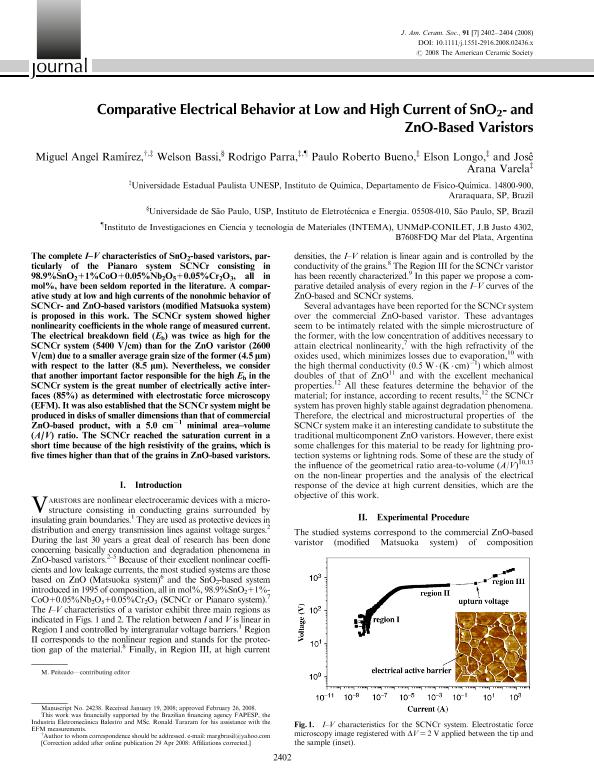Artículo
Comparative electrical behavior at low and high current of SnO 2- and ZnO-based varistors
Ramírez, Miguel Ángel; Bassi, Welson; Parra, Rodrigo ; Bueno, Paulo Roberto; Longo, Elson; Varela, José Arana
; Bueno, Paulo Roberto; Longo, Elson; Varela, José Arana
 ; Bueno, Paulo Roberto; Longo, Elson; Varela, José Arana
; Bueno, Paulo Roberto; Longo, Elson; Varela, José Arana
Fecha de publicación:
08/07/2008
Editorial:
Wiley Blackwell Publishing, Inc
Revista:
Journal of the American Ceramic Society
ISSN:
0002-7820
Idioma:
Inglés
Tipo de recurso:
Artículo publicado
Clasificación temática:
Resumen
The complete I-V characteristics of SnO 2-based varistors, particularly of the Pianaro system SCNCr consisting in 98.9%SnO 2+1%CoO+0.05%Nb 2O 5+0.05%Cr 2O 3, all in mol%, have been seldom reported in the literature. A comparative study at low and high currents of the nonohmic behavior of SCNCr- and ZnO-based varistors (modified Matsuoka system) is proposed in this work. The SCNCr system showed higher nonlinearity coefficients in the whole range of measured current. The electrical breakdown field (E b) was twice as high for the SCNCr system (5400 V/cm) than for the ZnO varistor (2600 V/cm) due to a smaller average grain size of the former (4.5 μm) with respect to the latter (8.5 μm). Nevertheless, we consider that another important factor responsible for the high E b in the SCNCr system is the great number of electrically active interfaces (85%) as determined with electrostatic force microscopy (EFM). It was also established that the SCNCr system might be produced in disks of smaller dimensions than that of commercial ZnO-based product, with a 5.0 cm -1 minimal area-volume (A/V) ratio. The SCNCr reached the saturation current in a short time because of the high resistivity of the grains, which is five times higher than that of the grains in ZnO-based varistors.
Archivos asociados
Licencia
Identificadores
Colecciones
Articulos(INTEMA)
Articulos de INST.DE INV.EN CIENCIA Y TECNOL.MATERIALES (I)
Articulos de INST.DE INV.EN CIENCIA Y TECNOL.MATERIALES (I)
Citación
Ramírez, Miguel Ángel; Bassi, Welson; Parra, Rodrigo; Bueno, Paulo Roberto; Longo, Elson; et al.; Comparative electrical behavior at low and high current of SnO 2- and ZnO-based varistors; Wiley Blackwell Publishing, Inc; Journal of the American Ceramic Society; 91; 7; 8-7-2008; 2402-2404
Compartir
Altmétricas



